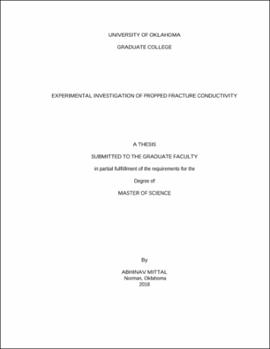| dc.description.abstract | Hydraulic fractures act as conduits connecting a wellbore to nanodarcy permeability unconventional reservoirs. Proppants are responsible for enhancing the fracture conductivity and help in maintaining high production rates. Laboratory testing of proppants can help in the systematic evaluation of different factors that can affect proppant performance. Field studies fail to control variables to allow evaluation of proppant performance. This study is focused on the measurement of long-term conductivity of proppant-packs at simulated reservoir temperature and pressure conditions. Various conductivity impairment mechanisms such as proppant crushing, fines migration, embedment, and diagenesis are investigated.
Testing was done using a conductivity cell, which allows simultaneous measurement of fracture compaction and permeability. The proppant-pack performance during compression between metal and shale platens was compared. The proppant filled fracture (concentration: 0.75-3 lb/ft2) is subjected to axial load (5000 psi) to simulate closure stress. Brine (3% NaCl + 0.5% KCl) is flowed through the pack at a constant rate (3 ml/min) at 250°F over an extended duration of time (10-60 days). In this study, Ottawa sand proppant was used between platen faces fabricated from Vaca Muerta and Eagle Ford shales.
In this study, effect of proppant size, time, rock mineralogy, fluid chemistry on proppant performance is evaluated. An attempt is made to decipher the contribution of different damage mechanisms in affecting proppant performance.
Testing between metal platens indicated the reduction in permeability with 20/40 mesh Ottawa sand (~30% over 12 days) was less than that of 60/100 mesh Ottawa sand which suffered a 99% reduction in only 4 days.
Measurements with 20/40 mesh Ottawa sand between shale platens were conducted at 1.5 lb/ft2. Over a duration of 10 days, the Eagle Ford platens proppant-pack exhibits a greater reduction in permeability, in comparison to Vaca Muerta platens. The normalized compaction for Eagle Ford shale platens is 20% more than Vaca Muerta platens, owing to greater proppant embedment. Particle size analysis and SEM images verify proppant crushing, fines migration and embedment as dominant damage mechanisms. These factors are observed to be dependent on the shale being tested. The results suggest a substantial degradation of permeability during the initial 5 days of testing, after which the permeability appears to stabilize. Crushed proppant and dislodged shale surface particles contribute to the fines generated; a greater concentration of fines is observed downstream.
Fracturing jobs involve maintaining a basic pH environment for optimal performance of fluid additives for better proppant placement via control on viscosity. Second study was conducted to compare performance on similar Eagle Ford shale by altering the fluid chemistry (pH: 10.5) to understand the impact on permeability and compaction over time. Over a duration of 20 days, the permeability dropped from 120 darcy to 200 md. After 8 days, the pH: 10 brine permeability was 10 times lower than pH: 7 brine permeability. After 18 days, the fracture width reduced by 90%, indicating a creep behavior. High silica content (>20 ppm) was observed in the outlet brine. The proppant and rock surface were studied under SEM to investigate the role of secondary mineral growth in the drastic reduction of permeability. | en_US |
